Several episodes of my life have featured long stretches of working at home, alone. At first, it was several years of writing my dissertation during graduate school. Then, it was several years spent on a failed neighborhood mapping concept. Now, due to the pandemic and its wake, I find myself permanently performing my salaryman duties at home — once again, alone.
When working at home, especially alone, the duties of working and feeding oneself must become integrated. An engine requires fuel, and without the benefit of a company canteen or a household chef to provide it, its preparation is likely to become woven into the workday.
At these times I turn to simple, hands-off dishes that I can leave on the stove, attended by nothing but a timer, so I can get back to work.
In another article, I described the joy of discovering that presoaking pasta can reduce its boiling time to only a couple of minutes. But even this requires 5 to 10 minutes, just to bring the water to a boil.
Now I am happy to report the discovery of a second revolution in pasta preparation, that lets many kinds of pasta be made in a hands-off way, so you can get on to more important things.
In this article, we’ll see how pasta can be steamed just like rice — requiring even less of your workday attention.
Cast off the yoke of the boiling pot
Similar to pasta, rice has long been a mainstay of my work-at-home diet. Everyone knows that rice can be cooked easily in an ordinary saucepan on the lowest flame, without any attention at all. Vegetables and other things like meat or sausage can be cooked with the rice; and if you melt some cheese into it when it’s done, you’ve got a one-pot meal of potentially infinite variations.
Now, what if I said you can do the same thing with pasta? Heresy!
Everyone knows, or thinks they know, that pasta must be boiled from dry, for ten to fifteen minutes, in a large amount of already-boiling water, until it has softened to a toothsome al dente. Many will ritually dose the water with a large amount of salt, and even cooking oil, for reasons I understand, but whose worth I have never seen convincingly demonstrated. Even if you subscribe to my pre-soaking method, you still must prepare some boiling water, and then boil the pasta for a couple of minutes. Steaming, it would seem, is simply too radical to even consider.
However, with some attention to detail, dry pasta can in fact be cooked like rice, by steaming it on very low heat in an ordinary saucepan, with just a little water.
Here’s the catch: You have to get the water-to-pasta ratio exactly right.
You’ll need a digital kitchen scale to measure the pasta and the water precisely (this is actually very easy).
Then, you may need to experiment with the amount of water and/or the cooking time, because success depends primarily on two things: (a) the heat of the lowest flame on your stovetop’s back burner, and (b) the tightness of the lid on the pot that you use.
Once you discover the formula that works for you, you might never boil pasta again!
Part 1: the general technique
This method works for the specific pot and the specific stove that I use. Remember, the exact amount of water and cooking time may differ for you — but you can find the right amount with just a little experimentation.
1. Measure exactly 100 grams of pasta into a saucepan. Do this by placing the pan on the scale, zero-out (“tare”) the scale, and drop in some pasta until it reads 100 grams.

2. Add exactly 260 grams of cold water. Again, “tare” out the scale and slowly add water until it reads 260 grams. Go slow near the end, so as not to overfill. If you do overfill, just pour some out. The amount of water must be within a few grams of the target.
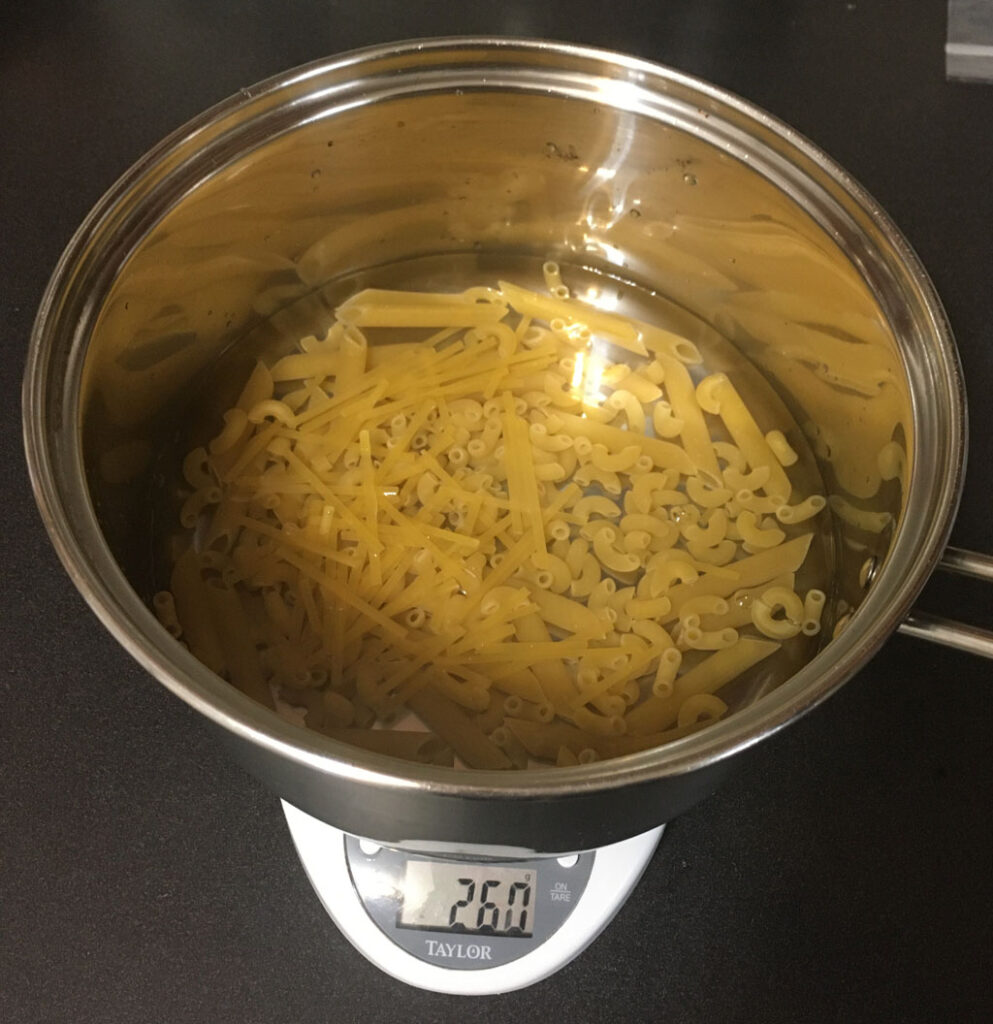
3. Bring to a full boil over high heat. Use a back burner, not the hottest burner – just like cooking rice. On my back burner, this takes about 3 minutes.
4. Then, as soon as it comes to a full boil, stir thoroughly with a fork to keep the pasta pieces separated.

5. Turn the heat to the lowest setting.

6. Then cover the pot with a tight fitting lid and set the timer for 20 minutes.

7. Check the pot in 20 minutes.
If you used the right amount of water (for your pot and burner), it’s done. The pasta should be cooked, and the water should have been absorbed almost completely. There may be a little starchy moisture in the bottom. If there is more moisture than what you see below, you may need to cook it a bit longer — and next time, use a bit less water.
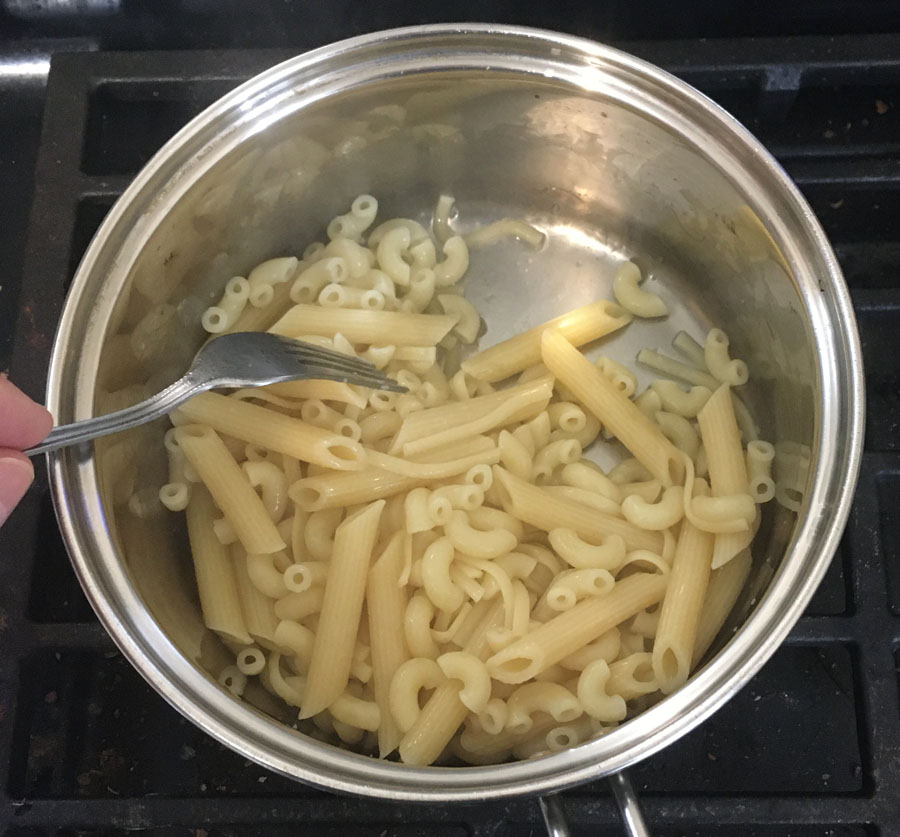
On the other hand, if the pasta has glued itself tenaciously to the pan and cannot be removed in complete and separate pieces, then you’ve got problems. Either the lid is allowing too much steam to escape, or your burner’s lowest setting is not low enough. The latter is a rare situation. Try using the smallest burner available. If you can successfully cook rice in a saucepan on the same burner, you should be able to do the same with pasta. But if you can’t get the heat that low, you might have to abandon this experiment.
Now we’re cookin’
From here you have a number of options. The pasta is hot, hydrated, and susceptible to suggestive ideas.
To prepare a simple and effortless macaroni and cheese, simply dice 1 to 2 ounces of cheddar cheese and mix it in to the hot pasta, while it is still very hot. Stir until the cheese melts completely. If the pasta is too dry, add a little hot water, and remember to adjust the water next time.

If everything went right, you now have a delicious plate of cheesy pasta, cooked perfectly, in a smooth cheese sauce — made from only two ingredients, pasta and cheese.
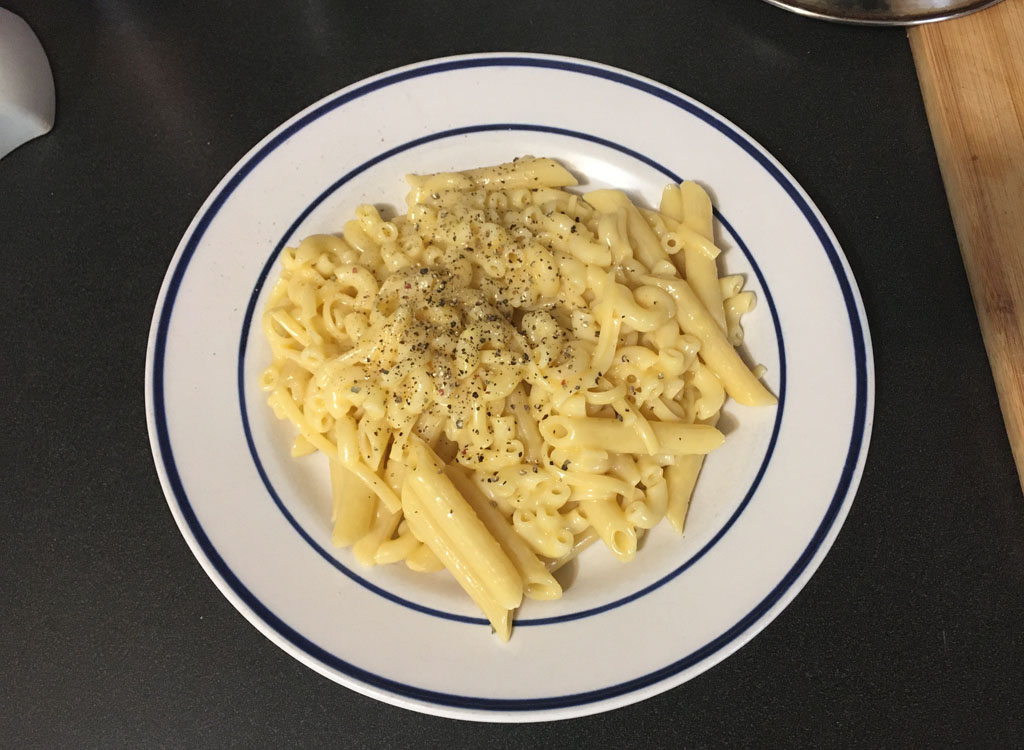
Caveats
- This method works best with short pasta, such as penne, rotini, macaroni, rigatoni, and so on. Long pasta such as spaghetti, linguini, or fettucini can be used, but they tend to stick to the bottom of the pan. If you must use long pasta, you should break it into shorter pieces. I do not recommend capellini.
- Larger, chunkier pastas should be cooked a bit longer. For example, a batch of 100% large penne may need perhaps 15-20% longer cooking time. SImilarly, thin pasta requires slightly less cooking time, as it absorbs water more quickly.
- Use a slow back burner, NEVER the hottest burner. The lowest heat setting on a big burner is probably too hot.
- If in doubt, start cautiously with a shorter cooking time and check periodically. If you can successfully cook 100 g of rice in 1 cup of water in 13-15 minutes at the lowest setting using a plain covered saucepan, your burner should be fine for this pasta method.
Part 2: Why and how it works
Although dry pasta is a staple of almost every Western kitchen, we seldom think of it as what it is: a dehydrated, preserved food. Preparing it involves rehydrating it, and gelatinizing the starch by application of heat.
Traditionally, this is done by boiling dry pasta in a large pot of water. But the underlying goal is to get the water and the heat into the pasta — and, tradition notwithstanding, there are multiple ways to do this.
Both water and heat can be introduced to the pasta by steaming, in a closed saucepan. During this process, some of the water will escape as steam, and the rest will be absorbed into the pasta. The key is to use exactly the right amount of water, keep the lid on tightly, and keep the flame sufficiently low.
As with any alternative method, there are advantages as well as drawbacks.
One advantage of traditional boiling is that the water doesn’t have to be measured accurately at all. It works anywhere, anytime. On the other hand, when the where is your home office, and the when is your workday, it consumes more time and attention than it should. And, it uses a lot of energy to boil that water and then discard it.
An advantage of steaming is that it takes hardly any attention at all – perfect for when your attention is spoken for. On the other hand, it requires accurate measurements, and maybe a little experimentation. But once you got it, you got it.
Solving for simplicity
Essentially, getting it right is a matter of solving for the right solution, in a solution space defined by only a few variables.
For the plain pasta baseline experiment, you are solving for the right amount of water, and the right cooking time, subject to the tightness of your lid (a fixed quantity) and the heat of your lowest flame (also a fixed quantity).

So, for a fixed amount of pasta, finding the solution involves varying the amount of water and the cooking time. For my lid and flame, the solution is 260 g of water for 100 g of pasta, and the cooking time is 20 minutes with the lid on. To find your own solution, I suggest starting with these quantities, and adjusting the water as needed. If it always turns out soupy after 20 minutes, try less water — cooking longer could also work, but the pasta might then overcook. If it always turns out dry, then try using a bit more water.
And remember, this article is about cooking a single serving, appropriate for one person working at home, alone — I have not tried scaling the recipe for two or more. It’s entirely possible that the mass and thermodynamics of a larger batch could alter the ideal pasta-to-water ratio, or the cooking time.
Let’s up our game!
So far, we have found that we can cook a pot of plain, bare pasta by steaming — all well and good. But plain, hot pasta lends itself only to a limited number of uses. Macaroni and cheese is one, but it can get a little old before long.
But this technique can be extended to a large variety of one-pot, pasta-centric meals, just by throwing in vegetables, spices, and other additions. Once you get the hang of plain pasta, you can try a lot of other things. Here’s one example.
1. Put into the pot:
- 100 g dry pasta (mix of penne rigate, small macaroni, and linguini broken into pieces)
- about 50 g sliced onion
- about 50 g brussels sprouts, cut in half or quartered (whole, if small) – or broccoli
- 2 mini sweet peppers, chopped or cut into quarters
- 1/2 sliced mild jalapeno or serrano (to your taste)
- 2 cloves garlic, chopped
- 60 grams cooked sausage, canned tuna, or similar (optional)
- Oregano, black pepper, fennel seed, and cilantro, or similar spices — to taste
- 100 grams crushed or pureed tomatoes (from a can or fresh)
- 230 grams water (reduced from 260 g, because the tomatoes provide some water)
- Also prepare, to be added later:
- one ounce of diced cheddar cheese

2. Bring to a boil over high heat. On the rear burner of my gas range, this takes about 4 minutes with the lid on. I just set the timer for 4 minutes and do other things during this time.
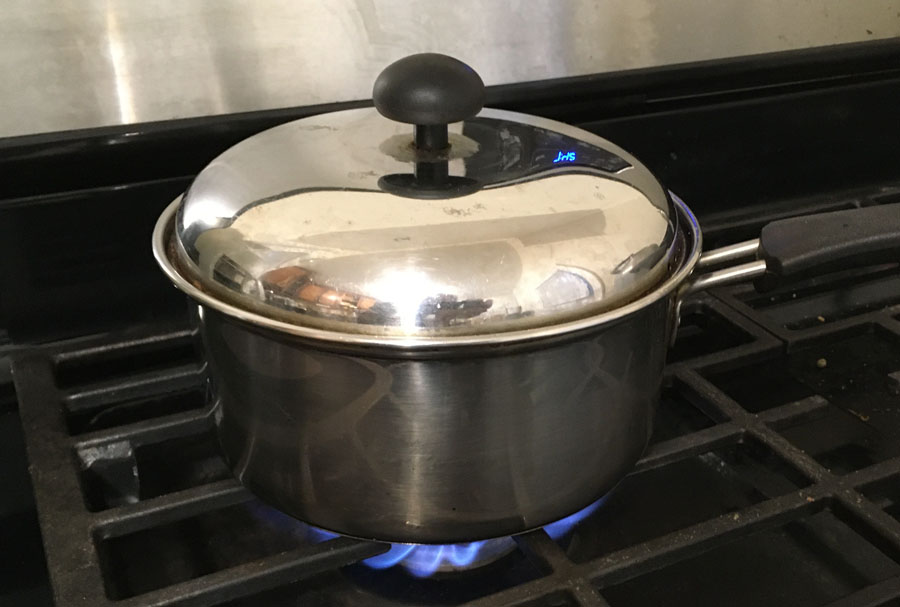

3. Once it has reached a boil, stir well to separate the pasta.

4. Bring it back to a boil, then
Turn the heat to its lowest setting, and then
Put the lid on.
Then set the timer for 20 minutes.

5. Check it after 20 minutes. If the pasta has absorbed the water, it’s probably done. Try a piece of the pasta, which will have absorbed the flavors of the other ingredients — it should be slightly al dente. Otherwise, put the lid back on and cook a few minutes longer. There should be very little moisture in the bottom of the pan, if any.
But again, if the pasta is far too dry and glued to the pan, then you’ve got problems. Either the lid is allowing too much steam to escape, or your burner’s lowest flame is not low enough. If the latter, and you can’t fix it, I don’t recommend this method.

6. While still piping hot, add the finely diced cheese, and mix well until the cheese melts. Season with salt to taste.

The end result is a creamy, slightly cheesy, casserole-type dish, that took very little time to prepare, and was hands-off for most of that time.
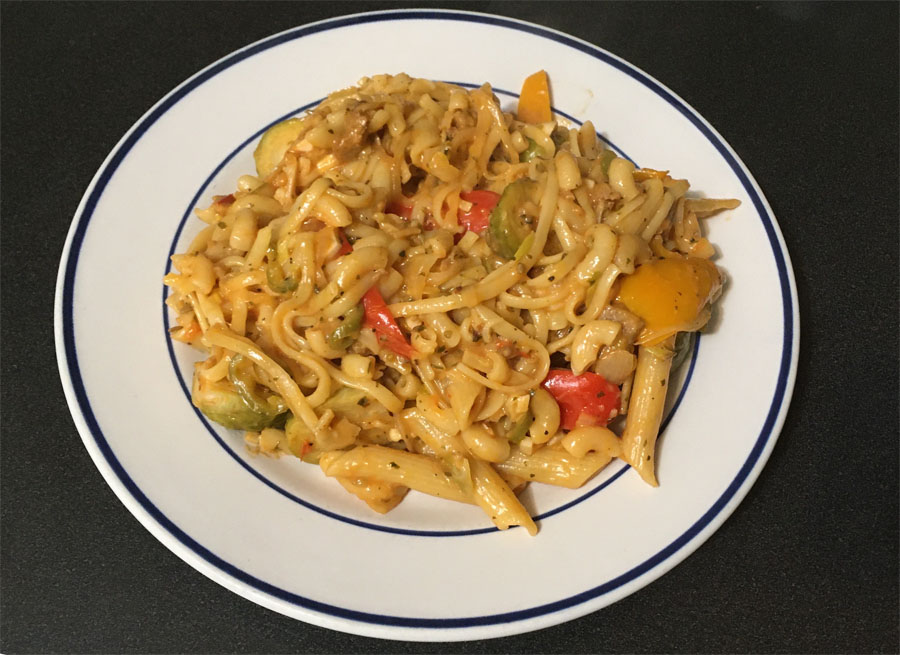
Variations
Since it creates a pasta-based, casserole-type dish, the ingredients can be varied to match whatever pasta-based casserole you wish to mimic. For example, a close stand-in for tuna casserole can be made by using half a can of chunk light tuna in place of the sausage, and a handful of frozen peas, and a little sour cream in place of some of the cheese. Or, you can edge toward a pizza-style casserole by using fresh basil, fresh oregano, pepperoni or italian sausage, and mozzarella (in place of the cheddar).
Consider this article an invitation to experiment. The results I have shown may not match your results exactly, until you have mastered the plain-pasta experiment by finding the right amount of water and the right amount of cooking time — assuming, of course, that your lowest stovetop heat setting, and the lid on your saucepan, are reasonably similar to mine.
As I developed confidence with this technique, it displaced many of my other work-at-home lunch options — even the presoaked-pasta method. This is almost the only way I prepare pasta now.
Find the method that works for you, and you’ll be saving time, energy, and attention — all the better for your creativity!


